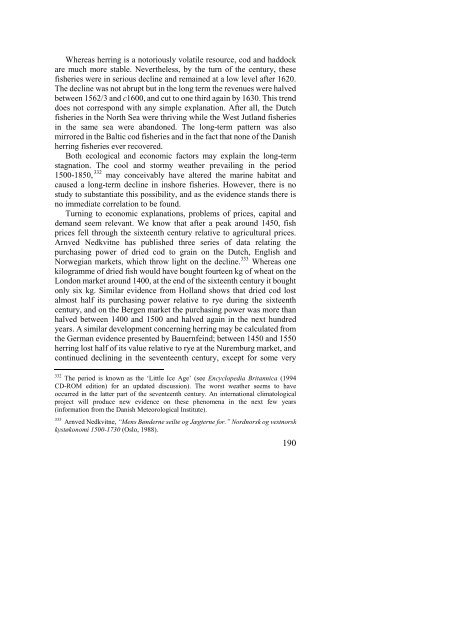The North Atlantic Fisheries, 1100-1976 - University of Hull
The North Atlantic Fisheries, 1100-1976 - University of Hull
The North Atlantic Fisheries, 1100-1976 - University of Hull
Create successful ePaper yourself
Turn your PDF publications into a flip-book with our unique Google optimized e-Paper software.
Whereas herring is a notoriously volatile resource, cod and haddock<br />
are much more stable. Nevertheless, by the turn <strong>of</strong> the century, these<br />
fisheries were in serious decline and remained at a low level after 1620.<br />
<strong>The</strong> decline was not abrupt but in the long term the revenues were halved<br />
between 1562/3 and c1600, and cut to one third again by 1630. This trend<br />
does not correspond with any simple explanation. After all, the Dutch<br />
fisheries in the <strong>North</strong> Sea were thriving while the West Jutland fisheries<br />
in the same sea were abandoned. <strong>The</strong> long-term pattern was also<br />
mirrored in the Baltic cod fisheries and in the fact that none <strong>of</strong> the Danish<br />
herring fisheries ever recovered.<br />
Both ecological and economic factors may explain the long-term<br />
stagnation. <strong>The</strong> cool and stormy weather prevailing in the period<br />
1500-1850, 332 may conceivably have altered the marine habitat and<br />
caused a long-term decline in inshore fisheries. However, there is no<br />
study to substantiate this possibility, and as the evidence stands there is<br />
no immediate correlation to be found.<br />
Turning to economic explanations, problems <strong>of</strong> prices, capital and<br />
demand seem relevant. We know that after a peak around 1450, fish<br />
prices fell through the sixteenth century relative to agricultural prices.<br />
Arnved Nedkvitne has published three series <strong>of</strong> data relating the<br />
purchasing power <strong>of</strong> dried cod to grain on the Dutch, English and<br />
Norwegian markets, which throw light on the decline. 333 Whereas one<br />
kilogramme <strong>of</strong> dried fish would have bought fourteen kg <strong>of</strong> wheat on the<br />
London market around 1400, at the end <strong>of</strong> the sixteenth century it bought<br />
only six kg. Similar evidence from Holland shows that dried cod lost<br />
almost half its purchasing power relative to rye during the sixteenth<br />
century, and on the Bergen market the purchasing power was more than<br />
halved between 1400 and 1500 and halved again in the next hundred<br />
years. A similar development concerning herring may be calculated from<br />
the German evidence presented by Bauernfeind; between 1450 and 1550<br />
herring lost half <strong>of</strong> its value relative to rye at the Nuremburg market, and<br />
continued declining in the seventeenth century, except for some very<br />
332 <strong>The</strong> period is known as the ‘Little Ice Age’ (see Encyclopedia Britannica (1994<br />
CD-ROM edition) for an updated discussion). <strong>The</strong> worst weather seems to have<br />
occurred in the latter part <strong>of</strong> the seventeenth century. An international climatological<br />
project will produce new evidence on these phenomena in the next few years<br />
(information from the Danish Meteorological Institute).<br />
333 Arnved Nedkvitne, “Mens Bønderne seilte og Jægterne for.” Nordnorsk og vestnorsk<br />
kystøkonomi 1500-1730 (Oslo, 1988).<br />
190















